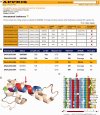APPRIS: annotation of principal and alternative splice isoforms
- PMID: 23161672
- PMCID: PMC3531113
- DOI: 10.1093/nar/gks1058
APPRIS: annotation of principal and alternative splice isoforms
Abstract
Here, we present APPRIS (http://appris.bioinfo.cnio.es), a database that houses annotations of human splice isoforms. APPRIS has been designed to provide value to manual annotations of the human genome by adding reliable protein structural and functional data and information from cross-species conservation. The visual representation of the annotations provided by APPRIS for each gene allows annotators and researchers alike to easily identify functional changes brought about by splicing events. In addition to collecting, integrating and analyzing reliable predictions of the effect of splicing events, APPRIS also selects a single reference sequence for each gene, here termed the principal isoform, based on the annotations of structure, function and conservation for each transcript. APPRIS identifies a principal isoform for 85% of the protein-coding genes in the GENCODE 7 release for ENSEMBL. Analysis of the APPRIS data shows that at least 70% of the alternative (non-principal) variants would lose important functional or structural information relative to the principal isoform.
Figures



References
-
- Gilbert W. The exon theory of genes. Cold Spring Harb. Symp. Quant. Biol. 1987;52:901–905. - PubMed
-
- Black DL. Protein diversity from alternative splicing: a challenge for bioinformatics and post-genome biology. Cell. 2000;103:367–370. - PubMed
-
- Pan Q, Shai O, Lee LJ, Frey BJ, Blencowe BJ. Deep surveying of alternative splicing complexity in the human transcriptome by high-throughput sequencing. Nat. Genet. 2008;40:1413–1415. - PubMed
-
- Nicholson P, Mühlemann O. Cutting the nonsense: the degradation of PTC-containing mRNAs. Biochem. Soc. Trans. 2010;38:1615–1620. - PubMed
Publication types
MeSH terms
Substances
Grants and funding
LinkOut - more resources
Full Text Sources
Other Literature Sources
Molecular Biology Databases

